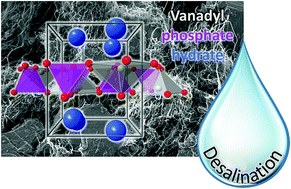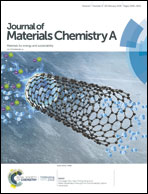Sodium ion removal by hydrated vanadyl phosphate for electrochemical water desalination†
Abstract
In recent years, electrochemical water desalination with battery electrode materials has emerged as a promising solution for energy-efficient salt-water desalination. Here, we report the promising desalination performance of a hydrothermally synthesized vanadyl phosphate material (mixed phases of sodium vanadyl phosphate dehydrate and vanadyl hydrogen phosphate hemihydrate) as a new electrode material. We observed robust stability of the synthesized electrode material over 280 cycles during desalination operation for 100 mM NaCl feedwater which was continuously flowing along the electrode material. During the first 100 cycles, the charge storage capacity was enhanced by 47%. This enhancement seems to be caused by a continuous conversion to vanadyl phosphate monohydrate from initial phases according to the post-mortem analysis by X-ray diffraction and infrared spectroscopy. The maximum sodium uptake capacity of the vanadyl phosphate electrode was 24.3 mg g−1 with charge efficiency of around 85%. We found no detectable level of contamination by phosphor nor vanadium from the treated water stream indicating that our synthesized electrode is also environmentally safe for water desalination applications.



 Please wait while we load your content...
Please wait while we load your content...